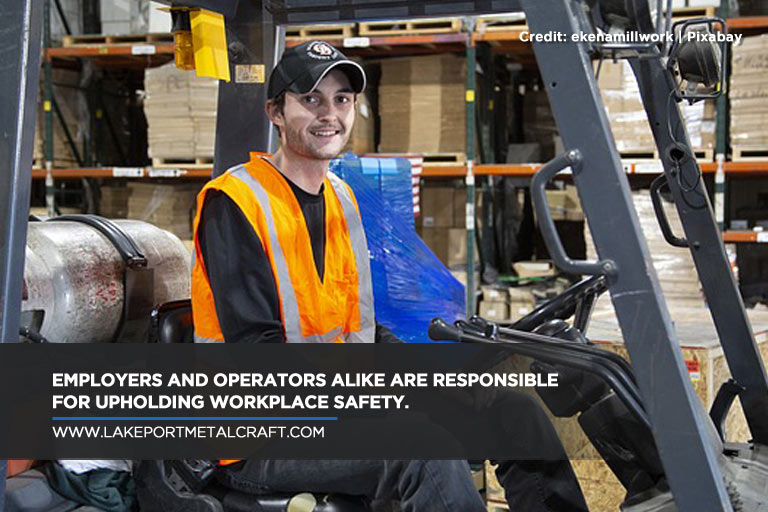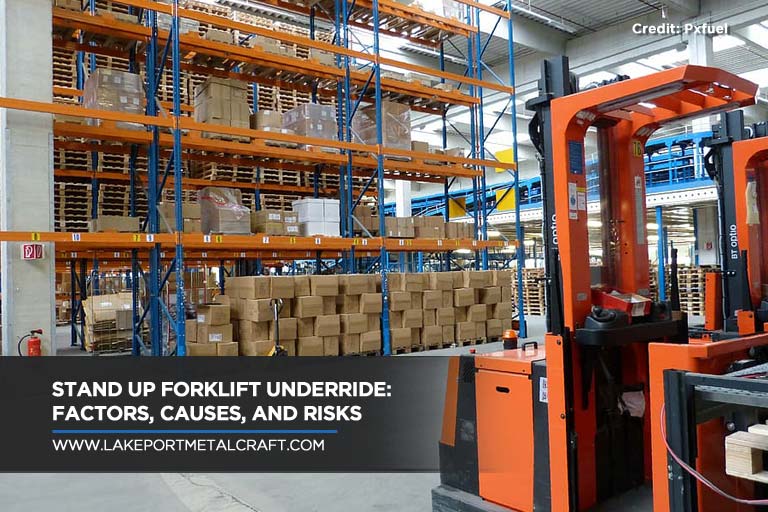“Underride” refers to forklift accidents that happen as a result of a standing operator backing too far into a horizontal shelf. The accident becomes fatal when shelving causes the forklift to slide below the shelf and crush the driver. In many workplaces, underride accidents are more likely to happen than overturning.
Studying 3,000 forklift accidents during a 2008 hazard analysis, the American Society of Mechanical Engineers (ASME) discovered that over 58% (1,693 incidents) were caused by collisions between a stand up forklift (or reach truck) vs. a stationary object, leading to 700 injuries and 22 deaths.
Accidents like this can be avoided through employee education, increased awareness of your surroundings, and upholding safety measures at all times. Learn more about the factors and causes of stand up forklift underride and how to minimize the risk of such an accident.
Who’s Responsible for Underride Accidents and Injuries?

While some forklift manufacturers put the burden of responsibility on the shoulder of the operators and workplace design, the truth is that both employers and operators have a role to play in preventing underride accidents. For starters, the employer can implement changes to the forklift and/or workplace design, while the driver can pay attention to where he’s going (particularly when backing up). Drivers are also encouraged to report any safety hazards to the management they notice at work.
Top Causes of Forklift Accidents

Accident risks are common when working with heavy machinery like forklift trucks. Organizations like the Canadian Centre for Occupational Health and Safety (CCOHS) have set regulations in place to ensure safe working conditions. However, factors like lack of training, malfunctioning equipment, and inattention when operating can still result in accidents.
Along with these general factors, below are the most common causes of underride that workplaces should prevent:
- Poorly trained operator
A forklift operator who has not undergone proper training might not be well equipped to handle operations in the workplace, especially when changes that have been recently implemented. New inventory, employees, obstacles, and even changes in floor gradient can throw off an inexperienced operator.
Should problems arise, the company will be held responsible for untoward incidents for not providing supervision. Before letting your staff drive a forklift, make sure to put them in a comprehensive training program that involves more than basic safety tips for driving a stand up forklift but includes an eye test, driving assessment, and a reflex assessment. Certify them after completing the training.
- Overspeeding
Driving a forklift too fast shortens an operator’s reaction time. One of the best tips for driving a stand up forklift or reach truck is to move slow.
- Workplace design
The design of your workplace can have an impact on your forklift operation and safety. Make sure to purchase the right forklift that matches your warehouse operations. A warehouse that has a minimal aisle space requires a narrow-aisle truck.
- Absence of markings and warning signs

Forklift routes and zones must be clearly marked, especially in workplaces with foot and forklift traffic. People should always be reminded to watch for a forklift each time they walk through these areas. Paint, standing signs, and floor tapes can be used to mark a forklift zone. Marks that show wear or tear should be replaced immediately to make them evident at all times.
- Driving a heavily loaded forklift
CCOHS regulations encourage operators to carry loads near to the ground or about 4 inches off the floor. Overloading may result in tip-overs or falling loads.
CCOHS also cites the following factors that can contribute to forklift-related accidents:
-
- Riding with the load elevated.
- Improper backing up techniques.
- Improper turning, braking or accelerating.
- Improper warnings to others about a forklift in use nearby.
- Riding or giving rides on forklift or load.
- Poor communication during shared tasks, or in shared spaces.
- Improper blocking of wheels on semi-trailers or railway cars.
- Horseplay; stunt driving; jerky, erratic driving.
- Inadequate servicing of the forklift.
- Not being aware of the route to be travelled (e.g., narrow passages, obstacles, poor surface conditions, etc.).
- Parking the forklift improperly.
Ways to Prevent Forklift Underride Accidents

- Communicate
To promote the highest levels of safety, site supervisors must communicate all areas that are prone to underride accidents. Job sites like warehouses, terminals, and distribution centers require such communication. As much as possible, take time to inspect and assess all areas with horizontal shelves that are highly accessible to standing forklifts. Site supervisors must ensure that safety measures are observed at all times. When all employees are aware of and appreciate the importance of safety measures, underride accidents will be prevented in the first place.
- Keep a direct line of sight
When driving lift trucks, operators must fix their eyes ahead. They must look to the direction of travel and never take their eyes off the path. When driving forward, fix your eyes ahead. When it’s time to back up, keep your eyes at the rear of the truck. You can also ask a coworker to assist you by providing another line of sight. Under CCOHS standards, forklift operators must take charge of their vehicles and keep them under close control throughout their shift (especially when approaching horizontal shelves).
- Run safety assessments
Regular and thorough safety assessments help lessen underride accidents. It is during assessments that hazards are spotted. Forklift operators also have a responsibility of reporting underride risks to their safety supervisors so they can be addressed right away.
- Comply with safety requirements
Make safety your company’s top priority. Start by ensuring that all employees are CCOHS compliant. CCOHS guidelines state that it is the responsibility of every employer to train and certify their staff, especially those who operate heavy machinery. If there’s any lapse in training or compliance resulting in an underride accident, CCOHS will demand for training records.
- Install protective rear guards
Injuries and fatalities related to underride accidents can be prevented with the use of safety accessories. An example of a protective accessory is the rear guard, a vertical post that runs from the body of the forklift to the overhead guard. Rear guards are specially designed to add a layer of protection for forklift drivers against collisions with horizontal shelves.
One of the most trusted rear guard brands is The Backbone®. It is designed and manufactured to be compliant with the ANSI/ITSDF B56.1 Standard to withstand impacts of up to 1.6 km/h. In addition to ensuring the safety of forklift operators from the hazards of rear-ward collisions, The Backbone® makes forklift protection faster and simpler for companies as it is easy to install.
If you need protection for drivers of your new or used stand up forklift, purchase The Backbone® from Lakeport Metalcraft Inc. and through our resellers worldwide. Our satisfied clients include renowned automotive manufacturers, big-box retail stores, and aerospace companies. Call us today for further information about The Backbone® or to get one for your forklift unit/s.

